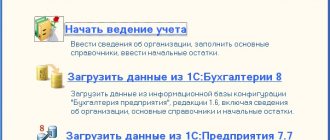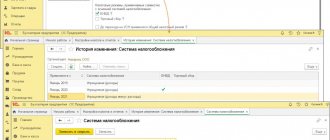Why is separate accounting of income and expenses necessary?
Paragraph 8 of Article 346.18 of the Tax Code requires that a payer operating under both taxation regimes - the simplified tax system and the UTII - maintain separate records of income and expenses within each. If this responsibility is ignored, it will become impossible to correctly determine:
- object of taxation “imputed”;
- tax base according to a simplified system.
A competent approach to organizing separate accounting for the simplified tax system and UTII will give the taxpayer the opportunity to easily monitor the amount of his income, which was received within the framework of the “simplified tax system”. Why is it important? The fact is that if the business turnover is considerable, you need to check every quarter to see if the income exceeds the limits established for “simplified”. Otherwise, expect a forced transfer of your case to the general tax regime with all the ensuing consequences (clause 4.1 of Article 346.13 of the Tax Code of the Russian Federation). Since tax reporting must be submitted based on the results of the past year, you will have to pay additional penalties and taxes for the quarter in which you exceeded the simplified tax system standards.
First of all, it is necessary to properly establish separate accounting of payments to employees involved in the business. Thus, insurance premiums will be distributed according to special regimes. The need for this arises because:
- on the simplified tax system with the object “income” and UTII, the amounts of insurance contributions are directed to reduce the tax itself
- in a “simplified” way with the object “income minus expenses”, existing insurance premiums go into expenses.
The taxpayer should always keep separate records of his subordinate employees, dividing them clearly among themselves by type of activity.
Accounting is being kept!
Thus, the first thing that needs to be recorded in the accounting policy, both in the simplified tax system section and in the UTII section, is that the enterprise maintains separate accounting for “general” costs.
In the section revealing the taxation rules under the simplified tax system, you can write, for example, the following:
Order
on the adoption of accounting policies at the enterprise
Order No. 80 “30” December 2009
Section I. Simplified taxation system.
If, along with activities subject to a single tax under the simplified tax system, business activities taxed by UTII are carried out, separate accounting is ensured by using the appropriate subaccounts of the enterprise’s working chart of accounts, as well as analytical and synthetic accounting registers in the context of taxable and non-taxable under the simplified tax system business transactions, property and liabilities.
And in the UTII section you can place a similar phrase:
Order
on the adoption of accounting policies at the enterprise
Order No. 80 “30” December 2009
Section II. A single tax on imputed income.
If, along with activities subject to a single tax on imputed income, other types of business activities are carried out, separate accounting is ensured by using the appropriate subaccounts of the enterprise’s working chart of accounts, as well as analytical and synthetic accounting registers in the context of taxable and non-taxable UTII economic entities transactions, property and liabilities.
How to do it right
So, in order to correctly calculate taxes under the simplified tax system, it should be separated from calculations based on “imputation”.
According to accounting laws, you need to enter a number of additional subaccounts into your chart of accounts in order to display on them the amounts of income and expenses according to certain types of activities. Moreover, separate sub-accounts may be required for transactions that are not related to either the simplified tax system or UTII.
The essence of separate revenue accounting is simple: this is the amount of revenue for each type of activity separately. A number of difficulties usually arise with internal accounting.
Income from imputation should include not only revenue from the sale of goods (work, services), but also other income that took place within the framework of this special regime. The Russian Ministry of Finance clarified that the concept of “other income” should include income received for fulfilling specific requirements of suppliers. For example, trading incentive payments from them. Please note: in this situation, we must not forget about the condition that the income was received within the limits of UTII. More examples:
- detection of income in the form of surplus after an audit;
- awarding penalties that your debtors must pay you.
There may be cases when wholesale trade is carried out on a simplified basis, and retail trade is carried out on UTII. In such a situation, the above-mentioned discounts, premiums and bonuses can be attributed to income that will be subject to UTII. But the principles of maintaining separate accounting remain key in this situation.
However, there is a significant caveat in the explanation of the Finance Ministry dated September 12, 2008 No. 03-11-04/3/430. The letter clearly states: it may happen that part of the income received as discounts, bonuses or bonuses cannot be unambiguously attributed to a specific type of activity performed. Then they cannot be distributed.
It is important to clarify that this letter refers only to UTII and the general taxation system. On the other hand, there are no restrictions for its use for another combination of modes - UTII and simplified tax system.
If you operate only within the framework of UTII, then the considered types of side income can be safely taken into account in this special regime.
We switched to the simplified tax system. What about expenses?
After such cases, when the former “imputed” type of activity becomes “simplified,” questions may arise related to the accounting of expenses incurred before this change. Here, for example, is the following situation (Letter of the Ministry of Finance of Russia dated October 29, 2009 N 03-11-06/3/257).
In 2008, the organization used the simplified tax system and UTII; since 2009, it switched completely to the simplified tax system. Expenses were distributed in proportion to the shares of income in the total amount of income received through the application of the simplified tax system and UTII. As of 01/01/2009, the organization still had arrears of wages and rent payments for 2008, this debt was paid in 2009. The following subtext can be found in the taxpayer’s question: under the simplified tax system, the cash method of accounting for income and expenses is used, is it possible to take into account on this basis expenses under "simplified" all those expenses that were paid during the period of its exclusive use, even if they relate to a different period?
Indeed, according to paragraph 2 of Art. 346.17 of the Tax Code of the Russian Federation, “simplified” expenses are recognized as expenses after their actual payment. For the purposes of ch. 26.2 of the Tax Code of the Russian Federation, payment for goods (work, services) and (or) property rights recognizes the termination of the obligation of the taxpayer - purchaser of goods (work, services) and (or) property rights to the seller, which is directly related to the supply of these goods (performance of work, provision of services ) and (or) transfer of property rights.
In this case, material expenses (including expenses for the acquisition of raw materials and supplies), as well as labor costs, are taken into account at the time of repayment of the debt by writing off funds from the taxpayer’s current account, payments from the cash register, and in the case of another method of repaying the debt - at the time of such repayment. A similar procedure applies to the payment of interest for the use of borrowed funds (including bank loans) and when paying for services of third parties.
Therefore, in the situation described by the taxpayer, in 2009, for the purposes of the simplified tax system, it is possible to take into account expenses incurred in 2008, but paid in 2009, including repayment of arrears on rent of premises and wages, but, in the opinion of the Ministry of Finance , only in the part related to business activities, taxed in 2008 under the simplified tax system.
The financiers did not further explain their idea. For our part, recognizing the legitimacy of this position, we point out the following. As noted above, due to the difference in what is considered a tax period under these special regimes, for the purposes of separate accounting, it is more appropriate, on the recommendation of the Ministry of Finance, to take into account income and expenses on an accrual basis from the beginning of the year.
In this case, expenses incurred in 2008 and related to activities transferred to UTII should have been fully taken into account in 2008, regardless of the fact of their payment. Consequently, there is no reason to take them into account in costs a second time, that is, in 2009.
What rules should you follow when maintaining separate cost accounting?
Separate accounting of income is not difficult - this is proven by everything described above. Much more difficult considering the costs. Especially if you use the simplified tax system with the object “income minus expenses” with UTII. Let's consider this combination in more detail.
The main rule of the Tax Code is this: when combining the above tax regimes, existing expenses must be distributed in proportion to revenues. True, in reality everything is not so simple. The following controversial points arise:
- What income is implied when calculating shares - all or just revenue?
- What period should be considered to determine the size of the proportion?
Transition rules
Do you combine special modes? Easily keep separate records and pay salaries in Kontur.Accounting. The service will calculate taxes, prepare payment slips, remind you of payment dates and automatically generate reports for sending via the Internet. Get free access for 14 days
Notify the tax office about the transition to UTII for a separate type of activity. No later than five days after the start of the application of the special regime, submit a corresponding application to the inspection.
Let's imagine the opposite situation. An individual entrepreneur or company operates on an imputed basis and wants to expand its activities. It is planned to apply the simplified tax system for a new line of business. In this situation, it will not be possible to immediately perform such a procedure. You can start using the simplification only from the new calendar year. Before this, you must also send a notification to the tax office. The second option is to close the enterprise and register again with a combination of simplification and imputation.
Income for proportion
It is generally accepted that the right decision is to choose the proportion of revenue for each area of activity as income for calculating the proportion. Side income (Article 251 of the Tax Code of the Russian Federation, etc.) is not taken into account when determining it.
It is correct from a legal point of view to apply this approach to income from the sale of property that is no longer in use and other similar types of income.
Let us recall that the revenue indicator should be determined in this way:
- under the simplified tax system, the cash method is used;
- with UTII, the basis is accounting information, although the cash method is also not prohibited.
In addition, let us add that there is another tax regime - the unified agricultural tax, which also provides for the cash method when calculating the amount of income. Based on the foregoing, when combining this special regime and UTII, you can use the approach described above to determine the proportion.
Where to get data for a reasonable distribution of expenses
Each figure involved in tax calculations and that can affect the final tax amount requires documentary confirmation. In a situation where the simplified tax system and UTII are combined, there is no common universal register containing the information necessary for calculating taxes.
To reflect expenses and income, as well as for a reasonable distribution of expenses when combining special regimes, you can choose one of the following methods for documenting “tax” information:
- book of accounting of income and expenses (for the simplified tax system) - simplifiers are required to enter income and expenses in this book, so you can use this data when distributing expenses;
For an example of filling out the KUDiR, see the material “How to keep a book of income and expenses under the simplified tax system (sample)?” .
- specially designed registers for recording income and expenses (for UTII) - since the calculation of UTII does not depend on expenses incurred and income received, there is no separate book for recording these indicators, so you can group the necessary data in separate tables;
- accounting data - both simplifiers and imputators, who are legal entities, are required to keep accounting, and with the correct construction of analytics (we will talk about this later), the necessary information can be taken from the accounting registers.
Detailed analytics is of great importance for obtaining reliable data on income and expenses and their further application in the distribution algorithm. The use of specific subaccounts and the degree of their detail for each company has its own characteristics depending on the specifics of their activities, cost structure, etc.
As an example, we can offer the following construction of analytical accounts:
| Index | Activities | |
| simplified tax system | UTII | |
| Revenue | 90.1/1 “Revenue from simplified taxation system activities” | 90.1/2 “Revenue from UTII activities” |
| Expenses taken into account without distribution | 44.1/1 “Sale expenses for simplified taxation system activities” | 44.1/2 “Sale expenses for UTII activities” |
| Allocable expenses | 44.1/3 “Common expenses for the simplified tax system and UTII” (in analytics by type of expense) | |
The information reflected in the accounting accounts must be reliable, and accounting is organized taking into account legally established requirements.
Period frame for proportion
According to the latest position of the Ministry of Finance, when calculating the proportion, income within the framework of UTII and for the simplified tax system with the object “income minus expenses” must be taken in an increasing amount from the beginning of the year. The tax period is not taken as a basis here, since for UTII it is a quarter, and for the “simplified” tax period it is a year.
Note that the one-year principle contradicts previously published letters from the Ministry of Finance. In them, officials argued that costs must be determined monthly, based on the amount of revenue and expenses for the month. Now the practice has been established for the annual period of final calculation of expenses on a cumulative basis.
Insurance premiums when combining special modes
Companies, merchants on UTII and simplified tax system are subject to the general requirements of the law and are required to pay certain insurance premiums for all subordinates. In addition, individual entrepreneurs also make contributions for themselves.
Accounting for insurance premiums has a number of features:
- for UTII and simplified tax system “income” the amounts of contributions must be deducted when determining the amount of tax;
- under the simplified tax system “income minus expenses”, contributions are included in expenses.
That is, insurance premiums must be divided among all types of activities. It's quite simple: you need to keep separate records of all employees and payments in their favor.
In accounting, subaccounts are opened for accounts 70 and 69, into which the amounts of insurance premiums are assigned by type of activity. For this purpose, three categories of subordinates are distinguished:
- employed on UTII;
- employed on the simplified tax system;
- employees involved in both special modes.
Basic information
UTII is a tax that replaces three taxes at once (VAT, personal income tax, property tax). Its size is set depending on what activities the organization is engaged in and does not depend on real income. You pay tax even if you haven't earned anything. But if your income is high, with imputation you can pay much less tax than with other regimes. Here we told you what UTII is and how to switch to it.
The simplified tax system also replaces several taxes with one, and with this tax system, simplified accounting is maintained. The tax is calculated at a 6% rate on income or at a 15% rate on income minus expenses. Here we talked about the features of the simplified tax system in comparison with UTII.
Employees are questionable
In practice, it is often unclear how to keep separate records of insurance premiums if employees cannot be divided by type of activity. Then one of three methods is used.
- The essence of the first method is that the amounts of insurance premiums are distributed proportionally according to the available share of income received by the company under the UTII or simplified tax system. When calculating UTII and simplified tax system “income”, contributions must be distributed in the same way as general expenses.
- The second method is based on the distribution of contributions in proportion to the received revenue parameter. The distribution in this situation should be monthly.
- The third method is based on distribution, which is rare today, in proportion to the specific gravity of payments. That is, income paid to employees is distributed in proportion to the revenue received from a specific activity relative to the total within the two regimes.
Read also
31.01.2017
Are you switching from UTII? Connect Kontur.Accounting
45% discount in November: RUR 7,590 instead of 13,800 rub. per year of work
Easy bookkeeping
The system itself will calculate taxes and remind you of the deadlines for payments and submission of reports.
Automatic calculation of salaries, vacation pay and sick leave
Technical support 24/7, tips inside the service, reference and legal database
Sending reports via the Internet
Reports and KUDiR are generated automatically based on accounting data
Electronic document management and quick verification of counterparties
Documents, transactions, analytical reports, VAT reconciliation
Keeping separate records of an organization working simultaneously on the simplified tax system and UTII is regulated by Article 346 of the Tax Code of the Russian Federation. There are no precise provisions in tax legislation on how to maintain separate tax accounting when combining tax regimes, so your main document will be the organization’s accounting policy. Treat the development of accounting policies with the utmost care. If it describes separate accounting in detail, you will have fewer questions from tax authorities.
From January 1, 2021, UTII will be abolished; combining this tax regime with the simplified tax system will also not work. Entrepreneurs can try to combine the simplified tax system and a patent, but organizations will no longer have the opportunity to combine them. Choose the regime with the minimum tax burden using our free calculator. If you are going to transfer all your activities from UTII to the simplified tax system or another tax regime, read our article - we have collected answers to the most popular questions about taxation systems. Didn't find the answer to your question? Ask it in the comments, we will definitely answer.









